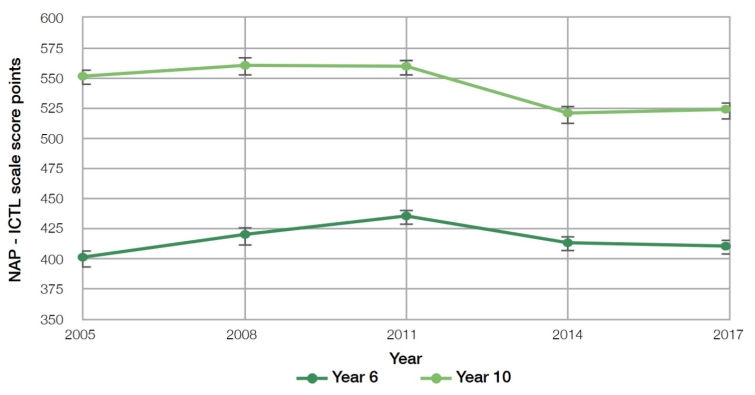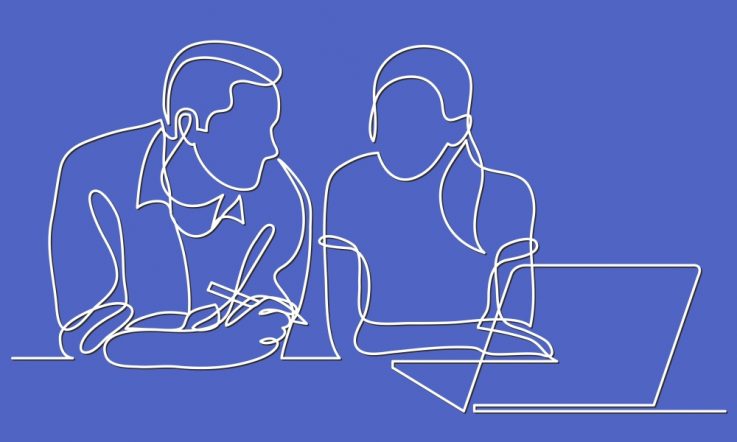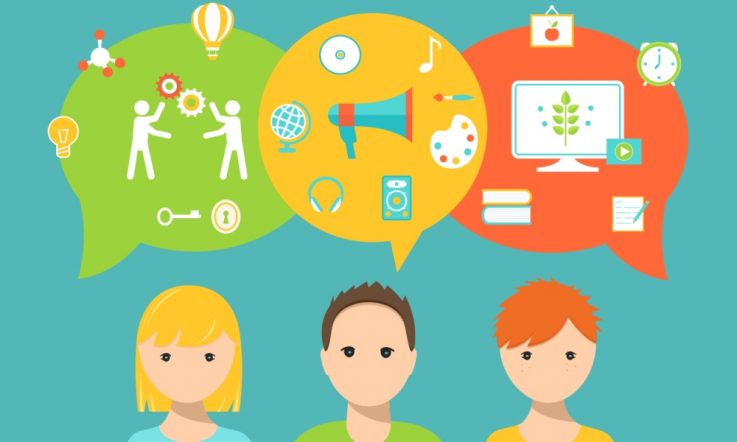Australian schools have suddenly and unforeseeably been forced to plan to implement internet-based remote schooling. What does this mean in a country where student use of ICT devices at school and outside of school is already high? Are students and teachers by default already sufficiently digitally literate and confident to manage the transition? ACER Research Director Julian Fraillon looks to Australian and international data to explore some of the myths and realities related to digital literacy.
Digital literacy, under a wide variety of names, is frequently reported as an area of high priority in school education systems internationally and relates both to how students learn to use digital technologies and how they can use digital technologies in their learning across other domains (Fraillon et al., 2019a).
In comparison with students in other countries, Australian students have high levels of access to digital technologies both at and outside of school. With this access comes the expectations that students will be highly-proficient users of digital technologies and that schools will use digital technologies in transformative ways to support student learning. Data from NAP – ICTL (the National Assessment Program – Information and Communication Technology Literacy) and the International Computer and Information Literacy Study (ICILS) 2013 and 2018 can shed light on some of the myths and realities associated with the learning and teaching of aspects of digital competence in Australia and across a range of other countries.
Myth 1: The rise of the digital natives
The idea that young people who are growing up with access to digital technologies develop ‘sophisticated knowledge of and skills with information technologies' as well as learning styles that differ from those of previous generations (Bennett et al., 2008, p.777) is naturally seductive to those of us who did not grow up with this same access. This notion of a self-developed capacity to use digital technology is at the heart of the concept of the ‘digital native' (Prensky, 2001). Adults frequently comment on the ease and apparent expertise with which young people use digital technologies. However, there remain questions about the sophistication and value of some of these skills. Can we assume that young people's innate digital literacy will allow them to easily transition to remote learning?
Both ICILS and NAP – ICTL measure and report the achievement of student digital literacy skills (in Year 8, and Years 6 and 10, respectively) on empirically-based achievement scales that include descriptions of the knowledge, skills and understanding expressed by students at different ‘levels'.
Table 1 includes the descriptions of the lowest level of achievement measured in each. Neither of the levels represents sophisticated use of digital technologies. Examples of achievements at Level 1 of NAP – ICTL are, ‘basic file and computer management functions such as dragging and dropping files' or applying generic commands such as ‘save as' or ‘paste'. Examples at Level 1 of ICILS include ‘insert an image into a document' or ‘use software to crop an image'.
In NAP – ICTL 2017, 13 per cent of Year 6 students and 3 per cent of Year 10 students nationally were at Level 1 or below on the NAP – ICTL scale (ACARA, 2018). In ICILS 2013, across all countries, 40 per cent of Year 8 students were at Level 1 or below and in Australia, which was one of the more highly achieving countries in ICILS, 23 per cent of Year 8 students were at Level 1 or below on the ICILS scale (Fraillon, et al., 2014).

Table 1: Lowest level of achievement measured in each of NAP – ICT and ICILS. (Fraillon et al., 2014, p.74; ACARA, 2018, p.24).
Clearly, of course, a great many Australian students (87 per cent of Year 6 students and 97 per cent of Year 10 students in Australia in 2017) are working above this lowest level. However, looking again at NAP – ICTL, in 2017, a further 33 per cent of Year 6 students and 10 per cent of Year 10 students achieved at level 2 on the scale (ACARA, 2018 p. 28). This level describes higher levels of technical use than the very basic skill execution of level 1, but still does not include evaluative or analytic decision-making regarding the use of information or independence when making decisions how to use technology.
So, in 2017, 46 per cent of Australian Year 6 students and 13 per cent of Year 10 students were not able work independently (i.e. to make decisions how to best use software for given purposes) or with a critical perspective when considering digital information.
Myth 2: Student digital literacy will continue to increase
The NAP – ICTL data reported above were collected in 2017 and a lot can happen in three years. With the ongoing development of digital technologies, increasing availability and increasing emphasis on the value of developing digital literacy (such as through the establishment of the Australian Curriculum: ICT Capability and more recently the Australian Curriculum: Digital Technologies) it is reasonable to hypothesise that young people's digital literacy will have increased over time and will continue to increase. Unfortunately, evidence from NAP – ICTL does not support this.

Figure 1: NAP – ICTL Year 6 and Year 10 average national scale scores (2005 to 2017).
The best data we have show very little change over time in the ICT literacy of Year 6 students, and a decrease since 2011 in the ICT literacy of Year 10 students (ACARA, 2018 pp. 27-29). There is no evidence to suggest that in 2020 the profile of student achievement in Australia should be considerably better than it was in the past.
It is important that schools and teachers keep in mind the likely reality that many students may not have the capacity to use technology without clear guidance and instruction and may need further support to develop critical information literacy skills. In the context of remote learning, the impact of deficiencies of these skills will be magnified as they may inhibit students' capacity to engage effectively with remote learning, as well as being necessary areas of learning themselves.
Myth 3: Boys use technology better than girls do
Data from NAP – ICTL and ICILS both contradict the general belief that boys will perform better than girls when using digital technologies. What the data tell us clearly thus far is that the opposite is true. Across all cycles of NAP – ICTL since 2005, the performance of Year 6 female students was significantly higher than that of male students and this was the same for Year 10 students across all cycles except for the first assessment in 2005 (in which the difference in performance between female and male students was not statistically significant) (ACARA, 2018). Similarly, in ICILS 2013 and 2018 female students outperformed male students in all but two countries (where, again, the difference in performance between female and male students was not statistically significant) (Fraillon et al., 2014; Fraillon et al., 2019b).
Myth 4: Digital technologies have transformed classrooms and pedagogy
There is no question that digital technologies offer teaching opportunities that previously had not been readily feasible. The internet provides opportunities to immediately access up-to-date information from around the globe. The ongoing evolution of (for example) communications, planning, simulation and online learning applications are resources that provide opportunities for a new world of teaching and learning. Does this mean that remote teaching and learning will naturally lead a proliferation of innovative digital teaching and learning practice?
While examples of highly innovative uses of digital technologies in schools are (rightly) promoted and lauded, the data suggest that these practices are the exceptions rather than the norm. In NAP – ICTL 2017, students were asked about the frequency with which they used digital tools for school-related purposes. The most commonly used tools reported by Year 6 and Year 10 students were word-processing software, presentation software and computer-based information resources (such as websites or wikis). Each of these tools was reported to be used at least once a month and by more than 60 per cent of Year 6 students and more than 70 per cent of Year 10 students. In contrast, simulations and modelling software, computer-aided drawing (CAD) software, data logging or monitoring tools and concept mapping software were reported to be used far less frequently by students. Typically, these were reported to be used at least once a month by between 15 per cent and 30 per cent of students at both year levels (ACARA, 2018).
In ICILS 2018 both students and teachers were asked about their use of ICT in their learning and teaching. The most frequent uses of ICT reported by students were: accessing computer-based information resources, using word-processing software and using presentation software. The most frequent uses of ICT in class reported by teachers were: presenting information through direct instruction in class, communicating with parents or guardians about students' learning, and the support of student-led whole-class discussions and presentations (Fraillon et al., 2019b). The least frequent uses of ICT for school-related purposes by students were: using tools that capture real-world data digitally for analysis, using concept-mapping software and using simulations and modelling software. The least frequently reported uses of ICT by teachers were: the provision of feedback to students on their work, the support of collaboration among students, and the mediation of communication between students and experts or external mentors (Fraillon et al., 2019b).
In ICILS 2018 we concluded that ‘despite the passage of time between 2013 and 2018 and the concomitant increase in the availability of digital technology resources for teaching and learning, the observation from ICILS 2013 that computers in school education were most commonly being used as digital textbooks remains valid,' (Fraillon et al., 2019b, p. 246).
In a time of remote learning, we face the challenge of how best to use digital resources in ways that go beyond using the technology to present and discuss ‘digital textbooks'.
Concluding thoughts
We live in a time of unprecedented and increasing access to digital technologies and proliferate use of digital technologies by young people in Australia, which often brings with it the assumption that, because the technologies look complex, the act of using them must be sophisticated. This comes with the corollary that young people are innately developing highly sophisticated digital skills.
In an unprecedented and unforeseen time with expectations of remote learning, we need to pause and reflect on the assumptions we can make about students' and teachers' preparedness to work in this environment. The research evidence suggests that we cannot assume that access to technology per se results in effective use and student learning. While we need to plan to support students to be able to make effective use of digital technologies in their learning, teachers too need support to manage this process.
This article is based on a paper originally published in the Research Conference 2019 conference proceedings.
References
ACARA. (2018). National Assessment Program – ICT literacy years 6 & 10 2017 report. ACARA. https://www.nap.edu.au/docs/default-source/default-document-library/2017napictlreport_final.pdf?sfvrsn=2 (4.3MB)
Bennett, S., Maton, K., & Kervin, L. (2008). The ‘digital natives' debate: A critical review of the evidence. British Journal of Educational Technology, 39(5), 775–786.
Fraillon, J., Ainley, J., Schulz, W., Duckworth, D., & Friedman, T. (2019a). IEA International Computer and Information Literacy Study 2018 assessment framework. Springer. https:// www.springer.com/gp/book/9783030193881.
Fraillon, J., Ainley, J., Schulz, W., Duckworth, D., & Friedman, T. (2019b). Preparing for life in a digital world. IEA International Computer and Information Literacy Study 2018 International Report. Springer Open. https://link.springer.com/content/pdf/10.1007%2F978-3-030-38781-5.pdf. (6MB)
Fraillon, J., Ainley, J., Schulz, W., Friedman, T., & Gebhardt, E. (2014). Preparing for life in a digital age. The IEA international computer and literacy information study international report. International Association for the Evaluation of Educational Achievement (IEA).
Prensky, M. (2001). Digital natives, digital immigrants: Part 1. On the Horizon, 9(5), 1–6.
As a teacher, what technical and information literacy-related skills are you assuming your students will need in order to work effectively in as remote, home-learning environment? How can you determine whether or not your students have these requisite skills? What can you do to address the gaps?
As a school leader, what do teachers in your school need to feel supported and comfortable to work in a remote, digital context?



